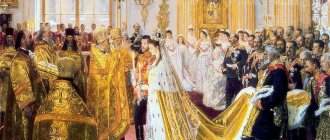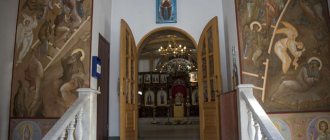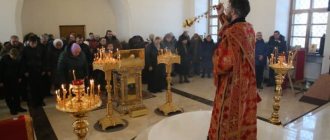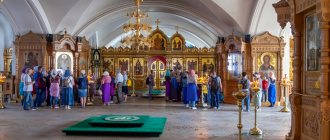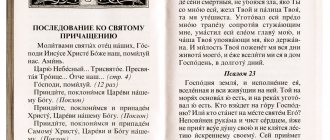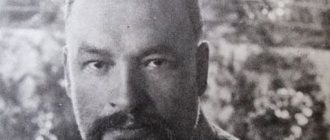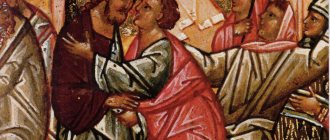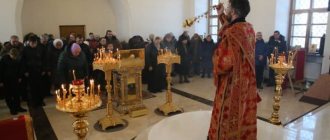Filled with the smell of incense (incense), the temple greets everyone who enters, as if letting him into a special world with its own smells, symbols, and laws. Incense in the Orthodox religion essentially means the prayer of the saints, this is stated in the Gospel:
And when he took the book, then the four living creatures and the twenty-four elders fell down before the Lamb, each having a harp and golden bowls full of incense, which are the prayers of the saints (Rev. 5:8).
That is, the prayers of everyone who is in the temple, like fragrant smoke, rise to God, calling on him for acceptance and favor. Just as incense has a pleasant aroma, so heartfelt, sincere, humble prayer is pleasing to God.
Therefore, it is worth taking a closer look at the censing process in order to understand its meaning and significance during the service.
Censer
Photo: Flickr.com
Censing occurs with the help of a censer - a metal container, which in liturgical practice is used during worship and services. Charcoal is lit inside the censer and incense is poured onto it. When incense burns, fragrant smoke is released - incense.
Censing is the most important symbolic action performed during worship. It has been held in churches since apostolic times.
From the history
Incense ritual
already existed in the Old Testament. Burning incense, which in ancient times was very expensive, was one of the types of sacrifice. By the way, incense was also burned in pagan cults. It can be assumed that the first Christians already performed incense, although direct evidence of this has not survived.
In the Old Testament Temple of Jerusalem, incense was performed using a golden scoop, which was used to pour incense onto the burning coals laid out on a large stone altar in front of the sanctuary. In Herod's day this was replaced with something like a frying pan.
The first incense burners most likely appeared in Ancient Egypt. They looked like shallow bowls on elongated legs and were made of bronze. In the houses of noble Romans, incense burners suspended on chains were used to burn incense.
In Christian worship, censers with chains appeared around the 6th century.
In Rus', censers on chains spread already in the 11th century, as evidenced, in particular, by the Charter of the St. Sophia Cathedral of Veliky Novgorod.
Censers in the shape of a temple have been known since the 15th century.
In addition to the spiritual and symbolic meaning, burning incense in the old days had a practical meaning. The use of incense gave the atmosphere of worship a special splendor and fought off unpleasant odors that could emanate from people. In addition, frankincense, known for its bactericidal properties, helped prevent the spread of disease.
The most ancient censers had approximately the same shape as they do now, but did not have a lid, which appeared later and has more decorative than practical significance.
In museums where ancient church utensils are kept, you can see gold and silver censers decorated with precious stones. At one time, they were created for temples and monasteries by order of kings and nobles. Since ancient times, the censer has been one of the most decorative attributes of the service.
History of incense
In Chapter 30 of the book of Exodus of the Old Testament it is written that the Lord himself commanded Moses to build a special altar in the temple, with the help of which incense would be carried out. In those days, the censers were stationary; only a few people could carry them using special stretchers. Thus, incense in churches was established from the very beginning of the Church and was carried out by the priests very carefully and reverently.
The New Testament says that the wise men, who learned about the birth of the Savior and came to worship him, brought, among other things, incense as gifts. This also speaks of the meaning of incense for the Lord - the very first gift.
Censers resembling modern ones began to appear during services in the 6th century. It was also a bowl on three chains that came together in the priest's hand. The first censers did not have a lid, so coals and incense were poured directly during censing.
In Rus', censers began to be used everywhere from the 11th century. The tradition came, like many others, from Byzantium. Around the 15th century, censers began to be made in the shape of a symbolic temple - a dome-shaped lid with a cross and slits for air access was added to the bowl.
Old Testament establishment of incense
During the Old Testament times, sacrifices offered to the Lord through so-called burnt offerings were common. Even before the time of Moses and long before the creation of the liturgical Old Testament tabernacle, the smoke from the sacrifices rising to the heights symbolized a person’s prayer addressed to heaven, to the Lord.
Since the advent of Old Testament worship in the tabernacle, incense before sacred objects has become a common practice. Thus, the Lord commanded the high priest Aaron to burn incense in front of the Ark of the Covenant, in which the tablets with the Ten Commandments were located. According to the book of Exodus, such a ritual was to be performed in the morning and evening. From the same Old Testament book we know about Moses performing incense before the golden altar, during which a cloud descended on the tabernacle and “the glory of the Lord filled it” (Ex. 40: 27, 34)
Symbols of incense
Photo: Azbyka.ru
The censer combines fire, coal and incense, placed in a censer vessel. The Holy Fathers of the Christian Church interpret their unification as follows:
- Fire warms, illuminates, but also burns, so it symbolizes the Divine. The fire of the incense coal is accordingly a symbol of the divine nature of Christ;
- Coal is of earthly origin, so it symbolizes the humanity of Christ;
- Incense symbolizes people's prayers offered to God;
- The censer is an image of the Mother of God, who contained within herself the Incontainable God. It is not for nothing that in some prayers the Mother of God is called the Incense Censer.
During the priest's censing of icons and shrines, praise is given to the Lord and the Saints. Hitting people means blessing and the descent of the Holy Spirit on them.
Each can be full or small. During full censing, the priest or deacon covers the entire temple, icons and worshipers with incense. At this moment, people present in the church should bow towards the censer, but do not necessarily spin around themselves, watching the minister’s passage through the temple. After all, incense testifies that the Holy Spirit descends on everyone who believes in God. Therefore, you should not fuss at such an important moment; it would be better to understand and accept the spiritual meaning of incense.
Small censing is carried out from the pulpit, while the altar, iconostasis and the people ahead are censing. This means that praise and honor are given to the Lord on behalf of everyone present in the temple.
When is censing performed at the all-night vigil and liturgy?
During the all-night vigil service, incense is performed several times. At the very beginning of the service, while the choir is singing the 103rd Psalm, which tells about the creation of the Earth, the priest walks around the entire temple with censing. At this time, the smoke of the incense symbolizes the Holy Spirit. The first verses of the Bible tell man about the creation of the planet:
Each night at the all-night vigil is also performed during the singing of the stichera at “I cried to the Lord” (vespers), during the litia (at the consecration of bread, wine, oil and wheat), the polyeleos (matins), and the song of the Theotokos “My soul magnifies the Lord.”
The censing is performed at the end of the proskomedia (before the liturgy). At the main service, during which believers partake of the holy mysteries of Christ, the censer is used during the funeral litany, the cherubic song, at the end of the Eucharistic canon (the priest censes the throne in the altar), after the communion of the believers.
Priest's prayer before censing
Photo: Flickr.com
Before each censing, the priest says the following prayer:
We offer the censer to You, Christ our God, into the stench (smell) of the spiritual fragrance, which is received into Your heavenly mental altar, bestow upon us the grace of Your Most Holy Spirit.
Thus, spiritual grace is invisibly present in the temple in the form of smoke emanating from the censer. This should strengthen believers in the fact that the Lord stands next to them during joint prayer.
What do the censer and incense symbolize?
A censer is a metal bowl on chains in which incense is placed on hot coals; During the service, the censer is rocked and shaken, spreading incense.
The censer is one of the symbols of Orthodox worship. Since apostolic times, censing has been performed during prayer. The fragrant resin of eastern trees - incense - is placed on hot coals in a metal censer. When burned, it produces fragrant smoke - incense.
The burning of sacrifices before God appeared on Earth in ancient times. It is enough to remember the sacrifice of the righteous Abel. The Lord himself in the Old Testament commanded Moses to make a special altar in the tabernacle for the sacred incense of aromatic substances. The Magi, who came to worship Christ, presented incense to the Infant God among other gifts. The Evangelist John the Theologian saw in Revelation in the Heavenly Temple an Angel receiving a golden censer.
According to the interpretation of the Holy Fathers, fire, as a substance that burns and warms, represents the Divinity. Therefore, the fire of incense coals signifies the Divine nature of Christ, the very substance of the coal signifies His human nature, and incense signifies the prayers of people offered to God. The censer is the image of the Mother of God who contained the Incontainable Christ. In many prayers the Most Pure One is called a fragrant censer.
Before starting the incense, the priest says a prayer: “We offer the censer to You, Christ our God, into the stench (smell) of the spiritual fragrance, which is received into Your heavenly mental altar, bestow upon us the grace of Your Most Holy Spirit.” From this prayer it is clear that the visible smoke of the censer means the invisible presence of the grace of the Lord, spiritually strengthening believers.
The liturgical censing can be full, when it covers the entire church, and small, when the altar, iconostasis and the people standing in the pulpit are censed. When incense is performed on sacred objects - icons, temples, it relates to God, giving Him due honor and praise. When the censer turns to people, this testifies that the Holy Spirit descends on all the faithful, as those who bear the image of God. According to tradition, it is customary to bow in response to censing.
In church you should always stand facing the altar, so during censing you should not turn your back to it, you just need to turn slightly towards the priest with the censer and bow.
Following the good news, the part of the vigil begins in the church, which can be called silent. It consists of censing the entire temple. The fact that this censing, which requires a lot of time, is supposed to be done before the start of the service itself and in the presence of all those gathered for it, who are invited to stand before it, as well as the thoroughness with which this censing is described in the Typikon - all this makes censing as would be a special service that precedes the all-night vigil and prepares for it, just as the evangelist prepares for it. The preparation here and there is of a different kind, but this makes it all the more comprehensive. Blagovest prepares believers for the service with sounds—music. The chopping prepares us for the service “with the scent of fragrance.” Spiritual, “mental” worship is preceded by this bodily, external one. Incense lifts the mind to the throne of God, where it goes with our prayers. In all centuries and among all peoples, the burning of incense was considered the best, purest material sacrifice to God, and of all the types of material sacrifice accepted in natural religions, the Christian Church retained only this and a few more (oil, wine, bread). And in appearance, nothing resembles the gracious breath of the Holy Spirit more than the smoke of incense. Filled with such high symbolism, incense greatly contributes to the prayerful mood of believers and with its purely bodily effect on a person. Incense has an elevating, stimulating effect on our mood. For this purpose, the charter, for example, before the Easter vigil prescribes not just incense, but an extraordinary filling of the temple with the smell from the placed vessels with incense.
In St. Sophia of Constantinople, at least before the service at which the king was present, the temple was filled with incense from special holes in the floor. In the "Book of the Pilgrim" Archbishop. Anthony of Novgorod (XII century), it is described as follows:
“The church is paved with red marble, and under it there is a whole (second floor), and people come up and pass through the marble. And when the king enters that church, then they will carry a lot of xylene (aloe) and incense (incense) under their underwear and put it on the coals and the stench will emanate from those passages into the church into the air.”
According to the Georgian charter. Shiomgvim Monastery XIII century The kandilov-burner censes the church between the first and second bells for the all-night vigil. Features of real censing:
a) the one who did it
Since the incense at the beginning of the vigil is the first in the circle of daily services, it is performed with special solemnity and is described in the same detail as in Chapter 22. Typikon, dedicated specifically to censing. At the beginning of the vigil, the censing (as well as the exclamation “Glory to the Saints...”) was moved from the beginning of Matins. Therefore, as there, it is performed by a priest, and not a deacon, due to the special importance of the moment. (Compare polyeleos; at the liturgy the deacon censes, since the priest is busy with more important sacred rites).
The historical basis for the performance of real incense by the priest is that Matins and Vespers were performed without the solemnity of the Liturgy, and therefore without a deacon; and in monasteries there was not always a deacon.
b) Burning a candle
Another feature of real incense, which it also has in common with the incense at the beginning of Matins and the polyeleos, is the presentation of a candle to the censing priest. At Vespers, as a service less solemn than Matins, incense is performed without a candle; during the liturgy, incense recedes into the background before other more sacred actions and therefore is performed with less solemnity, also without a candle.
The historical basis for this difference is that Matins, from the beginning of which the real incense was transferred to the beginning of the vigil, always began at night, before dawn, when it was impossible to walk around the temple and all its naves without a lamp; Vespers and the liturgy were always celebrated during the day.
But since the censing at the beginning of the vigil, like Matins, should not be as solemn as at the polyeleos, the lamp is ordered to be carried during the censing not by the deacon, as at the polyeleos, but by the paraecclesiarch or the candilo-burner. However, further in parentheses the Typicon notes that in cathedrals and parish churches “this deacon operates.” In the Kiev Pechersk Lavra, only at the beginning of Matins a monk in a robe presents a candle to the censing priest, and at the vigil a deacon presents it.
The historical basis for the statutory requirement that the censing priest be preceded with a candle by a paraecclesiarch, and not a deacon, is that the vigil in the absence of deacons was performed for the most part by one priest. In polyeleos it is different, because polyeleos was introduced into the service when monasteries for the most part had deacons.
The Typikon describes the particular censing before the vigil as follows. After the good news, the Kandilov burner or paraecclesiarch lights a candle in a candlestick and places it in front of the royal doors. In parish churches and in those monasteries where the all-night vigil begins with a deacon and a priest, the candle is carried by the deacon, who presents it to the priest during the censing of the altar.
In the Greek charter of the Shiomgvim monastery. XIII century there is no such remark about the candle (the kandilov-burner directly takes it in his hands before exclamation). In handwritten Greek. and glory Typicons of the XIII–XIV centuries. it was indicated to place this candle or lamp in the middle of the church. In the Typicons of the 15th and 16th centuries. it is indicated to place it either “directly with the royal door close”, or “in the middle of the church directly with the royal door”. So it is in the first printed editions of the charter. The main doors from the vestibule to the temple are called the royal doors; they, therefore, are understood here too, why the candle standing in front of them turns out to be in the middle of the temple. In the corrected copy of the charter for the 1672 edition, the words “in the middle of the church” and “close” are crossed out and, starting from this edition, are not included in the charter (they were retained in the Old Believer charter), apparently because the royal doors began to mean altar doors.
ABC of Faith
